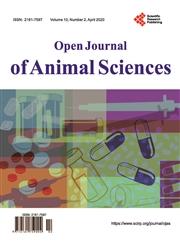Comparative Growth Performance, Carcass Characteristics and Meat Quality of Local Horro and Exotic Cockerels of Tropical Origin Fed Growers Diet
引用次数: 8
Abstract
Growth performance, carcass characteristics and meat quality of male chickens were evaluated using eight-week-old 360 cockerels from three exotic (Koekoek, Kuroiler and Sasso-R) and one Ethiopian indigenous (Horro) genotypes. Cockerels in each breed (90) were randomly allocated into three replications of 30 birds each and housed in deep litter pens for the experiment that lasted for 8 to 16 weeks. The experiment was arranged in a Completely Randomized Design. Seven birds per breed were slaughtered at the end to determine carcass yield, chemical composition and quality attributes of meat. The Kuroiler breed has higher body weight, body weight change (1621.8 g), average daily gain (28.9 g/day), daily feed consumption (127.4 g/day) and better feed conversion ratio (4.40) than other breeds. The Kuroiler breed has heavier slaughter weight (2716.3 g), dressed carcass weight (2201.0 g), eviscerated carcass weight (1905.1 g), breast weight (537.7 g), thigh weight (303.1 g) and drumstick weight (274.8 g) than other breeds. Total edible offal was higher for Kuroiler (324.2 g) and Sasso-R (306.1 g), intermediate in Koekoek (204.4 g) and low in Horro (152.4 g) breed. The relative proportion of breast and drumstick (% slaughter weight) were lower in Koekoek and Sasso-R (17.3 and 8.9) breeds, respectively. Abdominal fat weight (13.7 g and 1.02%) was lowest in Horro. Sasso-R showed higher percent edible offal weight (13.4%) than Horro breed (11.4%). The DM content in breast and thigh meat was higher for Horro breed than the rest. The CP content in the breast and thigh meat was lower for the Kuroiler and Koekoek breeds, respectively. Higher EE in the thigh meat was recorded for Sasso-R (8.9%), whereas, EE content in the breast meat was similar (3.4% - 3.7%) among the breeds. Flavor, tenderness, juiciness and general acceptability of breast and thigh meat were not affected by breed. The highest net return was observed in the Kuroiler breed. Based on the results obtained, it is suggested that the Kuroiler breed can be used for cockerel meat production in Ethiopia where intensive broiler production is not well developed.热带原产本地和外来公鸡饲养日粮的生长性能、胴体特征和肉质比较
选用3种外来基因型(Koekoek、Kuroiler和Sasso-R)和1种埃塞俄比亚本土基因型(Horro)的8周龄360公鸡,对公鸡的生长性能、胴体特性和肉质进行了评价。每个品种的小公鸡(90只)随机分为3个重复,每个重复30只,饲养在深窝中,持续8 ~ 16周。试验采用完全随机设计。每个品种末屠宰7只,测定胴体产量、肉的化学成分和品质指标。库罗尔品种的体重、体重变化(1621.8 g)、平均日增重(28.9 g/d)、日采食量(127.4 g/d)和饲料系数(4.40)均高于其他品种。Kuroiler品种的屠宰重(2716.3 g),屠宰胴体重(2201.0 g),全膛胴体重(1905.1 g),胸重(537.7 g),大腿重(303.1 g)和鸡腿重(274.8 g)比其他品种更重。可食用内脏总量库鲁鸡(324.2 g)和沙索- r (306.1 g)较高,库鲁鸡居中(204.4 g),霍罗鸡较低(152.4 g)。Koekoek和Sasso-R品种的胸肉和鸡腿的相对比例(屠宰重的百分比)较低(分别为17.3和8.9)。腹部脂肪质量最低,为13.7 g,为1.02%。沙索- r品种可食用内脏重量的百分比(13.4%)高于霍罗品种(11.4%)。Horro品种的胸肉和大腿肉中DM含量高于其他品种。库鲁犬和库奇犬的胸肉和大腿肉中粗蛋白质含量较低。沙索- r鸡腿肉的粗脂肪含量较高(8.9%),胸肉的粗脂肪含量基本相同(3.4% ~ 3.7%)。鸡胸肉和大腿肉的风味、嫩度、多汁性和一般可接受性不受品种的影响。净收益最高的品种是库罗尔犬。根据所得结果,建议在集约化肉鸡生产不发达的埃塞俄比亚,Kuroiler品种可用于公鸡肉生产。
本文章由计算机程序翻译,如有差异,请以英文原文为准。
求助全文
约1分钟内获得全文
求助全文

 求助内容:
求助内容: 应助结果提醒方式:
应助结果提醒方式:


